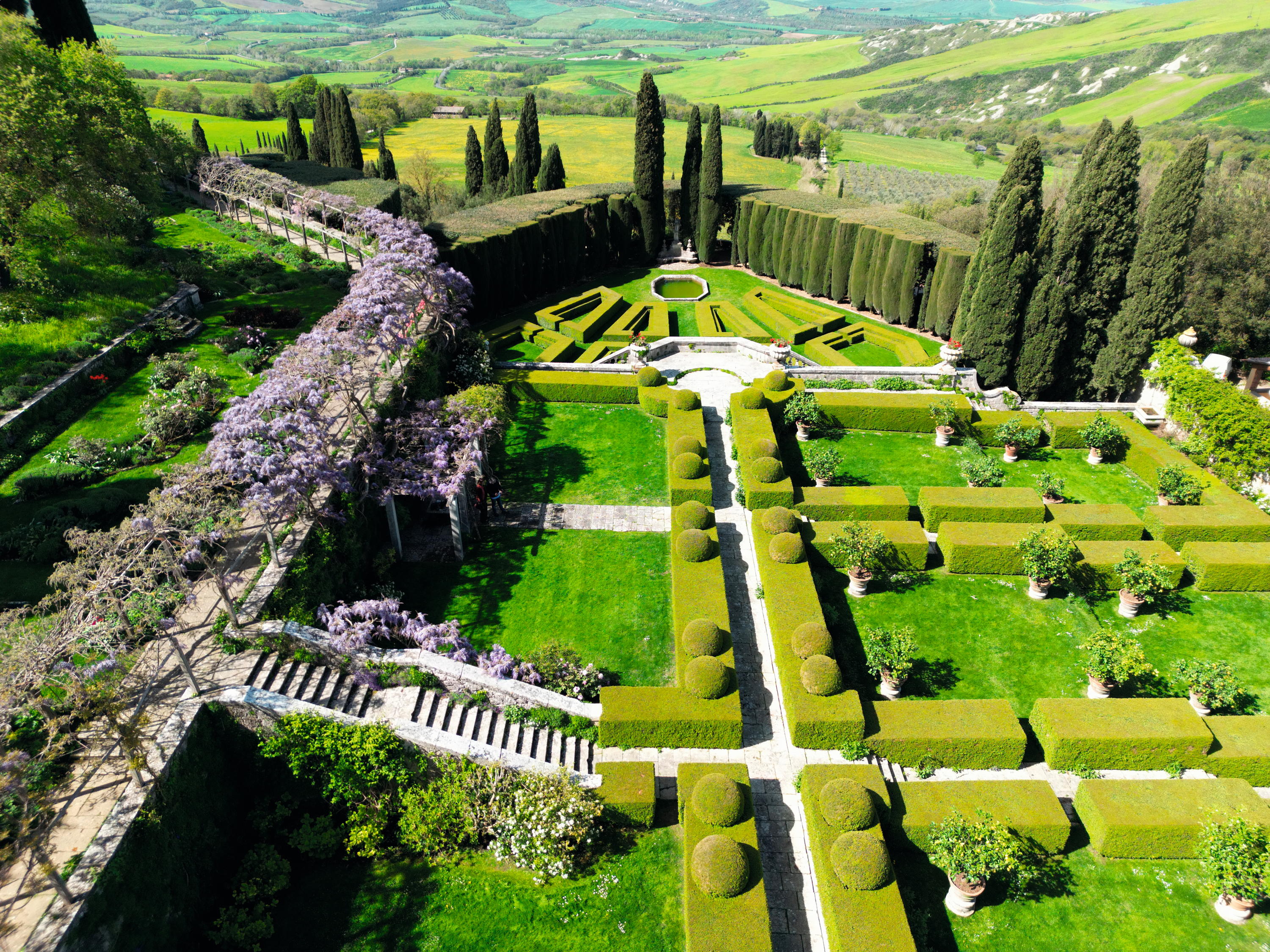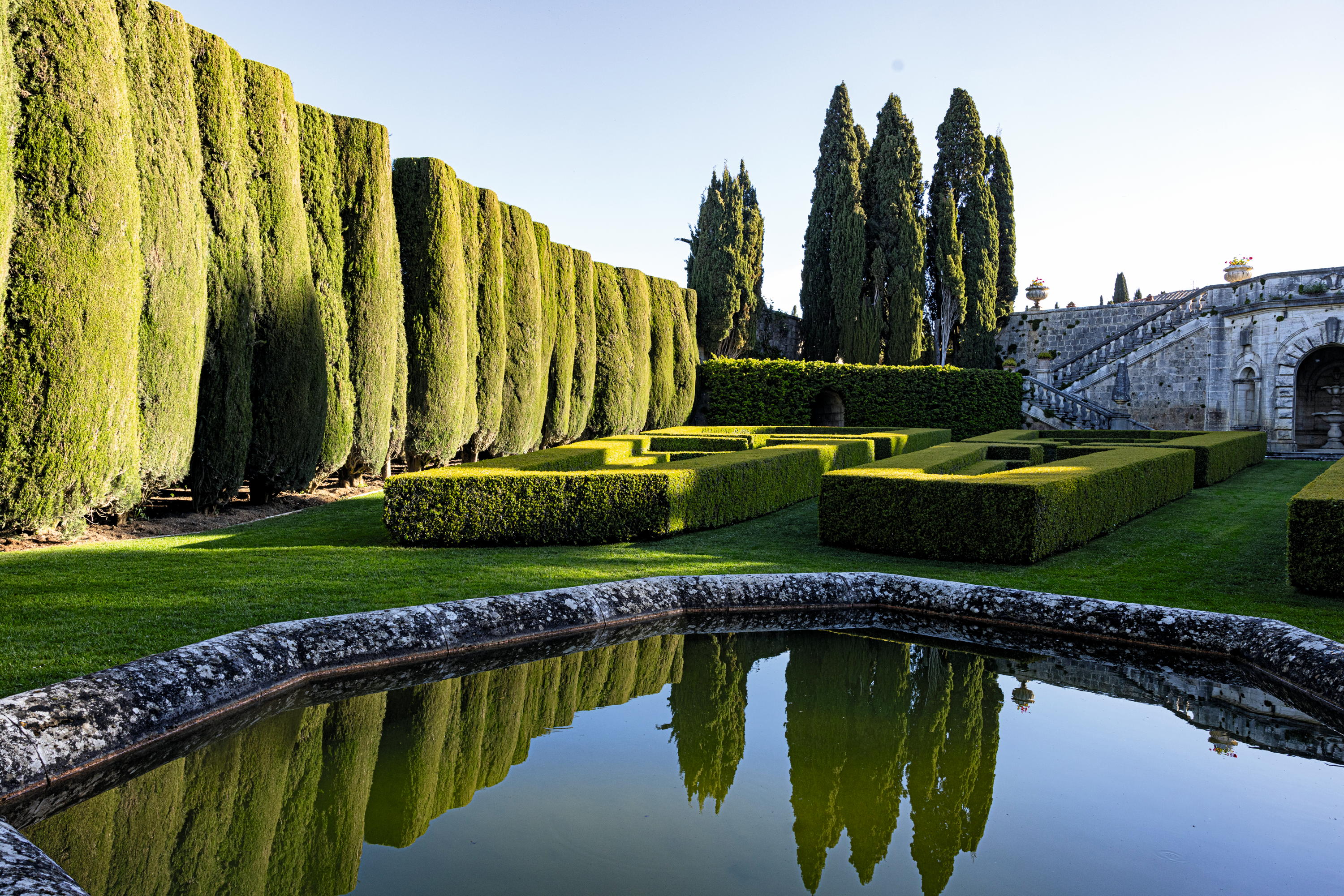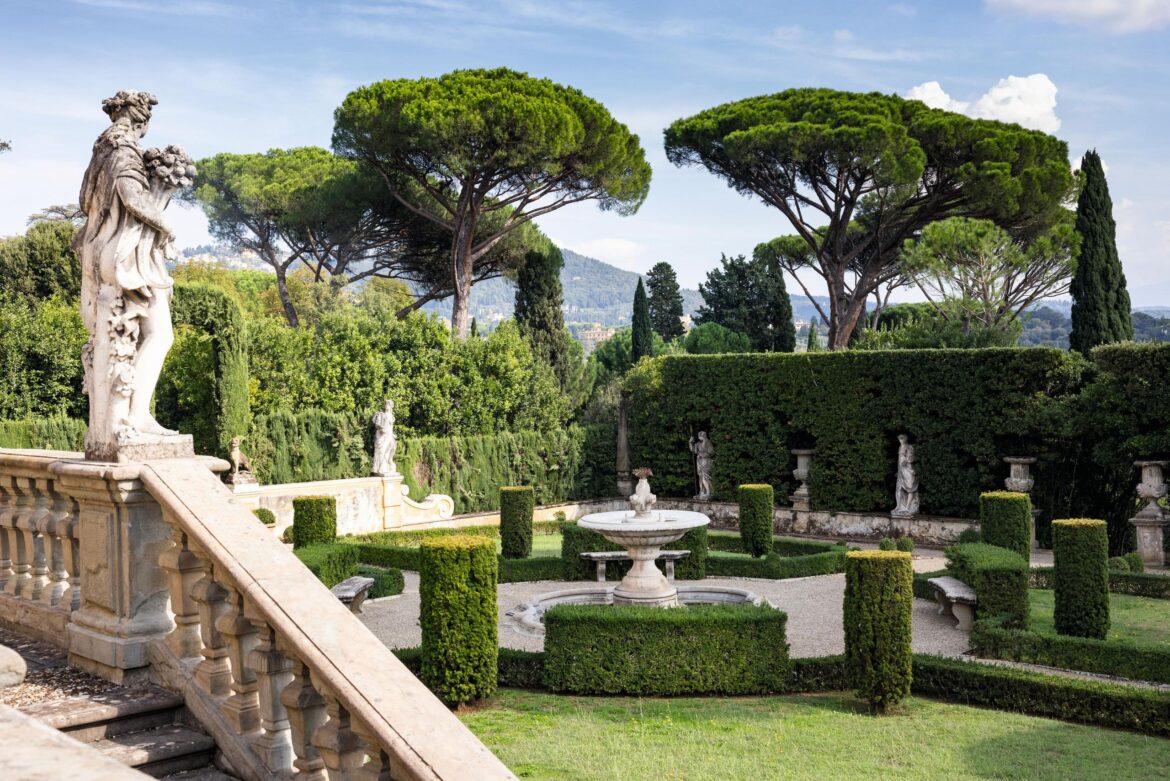In England, a substantial country house might be sited in a sheltered combe. In Tuscany, by contrast, an exposed, hilltop site is the location of choice. In the past, defensive considerations were important, but more abundant winter light and cooling summer breezes have ever been sought. Above all, such elevated positions enable the garden to bring in the wider landscape to dramatic effect.
Villa La Pietra (Country Life, July 19, 2007), widely regarded as one of Italy’s most famous gardens and only a stone’s throw from the centre of Florence, would not be the same without the borrowed Tuscan landscape that forms the backdrop to its formal garden. A series of individually themed garden rooms, terraces and staircases is linked by vistas that terminate in views of statues and fountains, the sight of rolling Tuscan hills punctuated with Italian cypress trees and tailored views of Florence’s world-famous Duomo. Even the garden’s Teatro di Verdura, the open-air theatre, has columns in its foyer framing a piece of Tuscany’s rural idyll.
The most impressive borrowed landscape in Tuscany must, however, be the one that is the making of Villa La Foce. The house, garden and surrounding landscape are largely the result of three very talented people: the Marchese Antonio Origo, his wife, Dame Iris Origo, and her friend the English architect Cecil Pinsent, who worked together on its design from 1927–39. Dame Iris’s book War in Val d’Orcia gives an enthralling and personal account of the impact of the Second World War on the estate and an idea of the character of the woman who strove to create the garden oasis that became its beating heart. It was Iris who fought to ensure the garden had its own water supply in an area where her husband may have preferred every drop be used for crops, but it was Pinsent who made her dreams a design reality. Taking inspiration from the Italian Renaissance and Baroque, the style was distinctively his, yet also wholly Italian and a part of its surroundings: the World Heritage landscape of the Val d’Orcia.

The borrowed landscape of the World Heritage Val d’Orcia in southern Tuscany makes a visit to Villa La Foce unforgettable
(Image credit: Matteo Carassale)
Pinsent’s masterly embrace of local, long-established, garden-making practice resulted in work that feels genuinely Tuscan. Formal gardens in Tuscany tend to have a warm humanity that is rarely sensed when visiting their Italianate cousins in Britain. With a tape measure in hand, the British appear more confident following logical rules; lots of right angles and mirrored beds of equal size. A close inspection of La Foce’s formality reveals the agreeable compromises Italians are accustomed to making in many aspects of their daily lives. Flowerbeds that appear so square turn out to be anything but and off-line paths through garden rooms take their cue from focal points rather than the tape measure. It is the eye that guides the layout of a formal Italian garden, more than any measurements. Villa La Pietra has a 560-year-old walled garden where ordered formality rules, yet there is no right angle or corresponding measurement to be found. Each bed is home to the same number of potted lemon trees, yet the distance between each is unique: an acceptance of human imperfection in the quest of an ordered paradise.
The bones of many of Britain’s best Arts-and-Crafts gardens are the result of similar practices. Think of Sissinghurst Castle in Kent, where Harold Nicolson, drawing on centuries of garden-making in Italy, was largely responsible for its formal structure. Into it his Italian-speaking, Tuscany-visiting wife, Vita Sackville-West, squeezed loose, romantic, colour-conscious planting schemes in the ‘Made in Britain’ style that is, today, loved the world over. Some of Sissinghurst’s bigger pots even came from Impruneta, a town near Florence that has produced the very best terracotta pots since the time of the Medici, yet they are filled not with lemon trees, but with very English flowering plants.

The lower terrace at Villa La Foce, where the stately cypress trees and smoothly clipped box hedge are reflected in the formal pool.
(Image credit: Matteo Carassale)
The same classical form with romantic fillings may also be seen at Torre di Sopra, to the south of Florence. Originally a Tuscan farmhouse, it was gentrified and a garden added by Antonio Maraini, the renowned Italian sculptor and his British wife, Yoï, a model, shortly after the First World War. Although Nature eventually reclaimed it as her own, it has now been fully restored and developed by a Norwegian couple as their family home. The result sees Yorkshire rhubarb growing alongside more typically Tuscan fare in the vegetable garden, borders that would not look out of place at Sissinghurst and lots of those Tuscan terracotta pots, filled with citrus trees.
Like a Great Dane attempting to hide amid a lively pack of smaller dogs, the biggest citrus fruit in the world, Citrus maxima (F) or pummelo, grows in the biggest terracotta pot in Tuscany at Villa Medicea di Castello, a UNESCO World Heritage listed garden close to Florence (Country Life, July 8, 2016). The pot has a diameter of more than 6ft and, together with the compost it contains and the plant itself, weighs in at more than four tons. Each year, a special crane is hired to move it in and out of the garden’s Limonaia or Lemon House. A Herculean task, but, in reality, only two half-days of work amid the two months it takes three gardeners to ensure Castello’s entire collection of potted citrus trees passes the cold Florentine winter indoors.

The view from the formal garden at Villa La Pietra, across the estate’s olive groves, to Florence’s famous Duomo
(Image credit: Matteo Carassale)
Commissioned by Cosimo I de Medici in 1538, Castello is considered to be the prototype of the 16th-century Italian garden and should not be left out of any tour of Tuscan gardens. With an impressive range of statues, fountains and one of the most famous grottos in the world, its architect, Niccolò Tribolo, ensured the garden became a celebration of his client’s power. A project to restore La Grotta degli Animali, the Grotto of the Animals, has recently been completed and now provides visitors with a tangible insight into the sophistication and beauty that became the hallmark of the Italian Renaissance garden.
Sandro Botticelli’s Primavera of 1482, now displayed in Florence’s Uffizi Gallery, was first hung in Villa Castello. The flowery swathe beneath Venus contains at least 138 identifiable species of wildflowers and represents a diversity that was later emulated in the garden’s lawns. Many of these species were native to Italy, but records show that some were brought to the garden from other lands. Today’s head count of such flowers is reduced, but they, together with the intense perfume of the Zagara, citrus blossom and the fresh green shoots of the lemon trees, make a spring visit to Castello particularly special. It offers a chance to see that Tuscan formal gardens are not, as is often claimed, about human dominance over the natural world, but more the result of a deep understanding of Nature and an ability to coax plants into being dynamic elements in these great works of art — all set against the ever-present Tuscan countryside.
Nick Dakin-Elliot is responsible for the gardens and grounds of Villa La Pietra and Villa Torre di Sopra.
Join the Country Life / Boxwood Garden tour to Florence
Join Country Life contributors Nick Dakin-Elliot and garden historian Marion Mako on a five-day horticultural journey through Florence and Tuscany, timed to coincide with the blooming of the irises and citrus blossom that mark a highlight of the Tuscan spring. The tour begins in Florence, where exclusive access to some of the city’s most beautiful and rarely seen gardens awaits. Discover Renaissance masterpieces that reflect the city’s golden age, followed by elegant early-20th-century gardens designed by Cecil Pinsent. In the Tuscan countryside, the gardens of Villa La Foce, created for Iris and Antonio Origo, offer a striking blend of Italian formality and English romanticism.
Throughout the tour, Nick will share his expert insights into garden conservation, drawing from his work restoring the historic Villa La Pietra. During the tour, you will stay at the elegant five-star Hotel Regency in Florence and enjoy private lunches with garden owners along the way. This carefully curated escape combines horticultural excellence and Italian sophistication — perfect for garden lovers.
The cost of the five-day tour, including four nights at the Hotel Regency, Florence, and flights is £5,295 (single supplement is £750). For further information and to book (with a deposit of £450), please telephone 01280 430175 or visit the Boxwood Tours website.


Comments are closed.